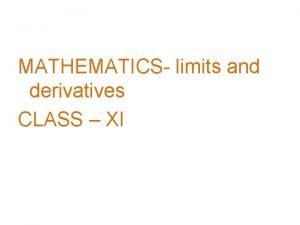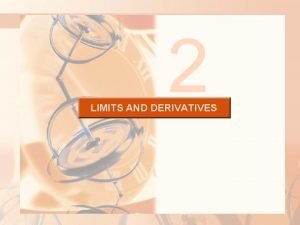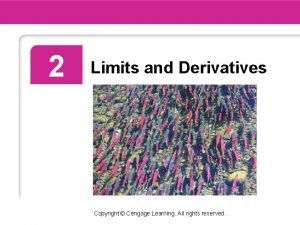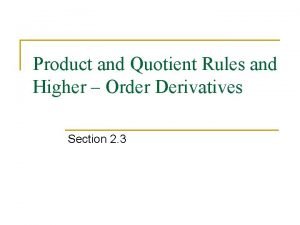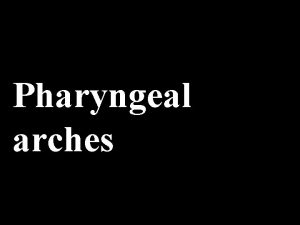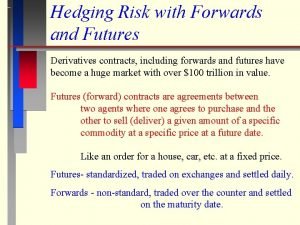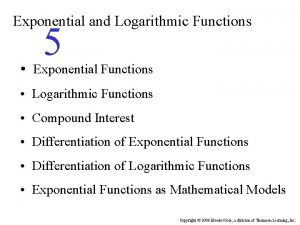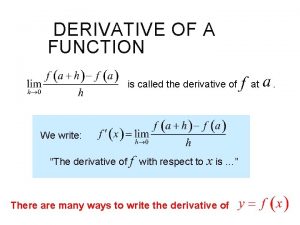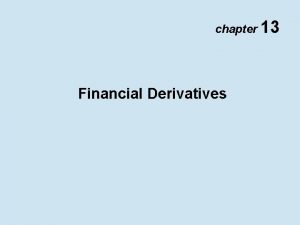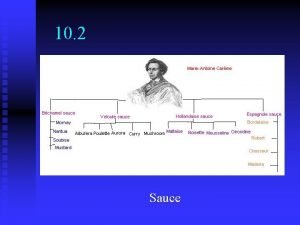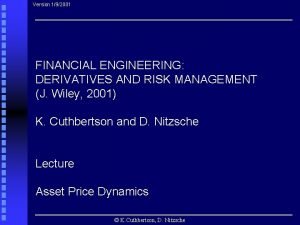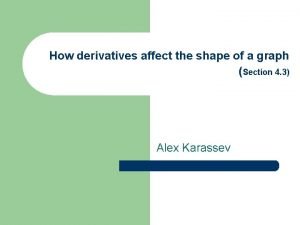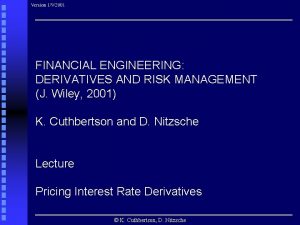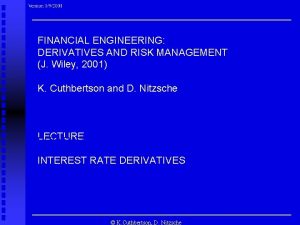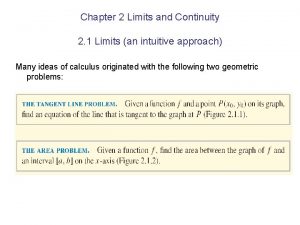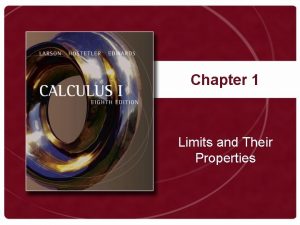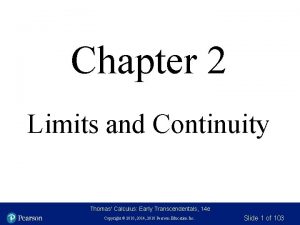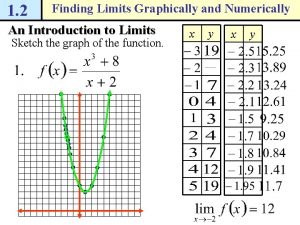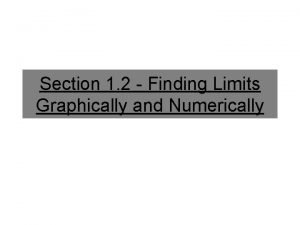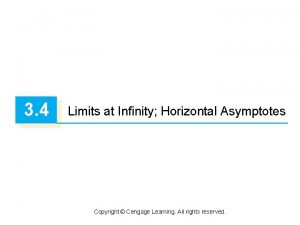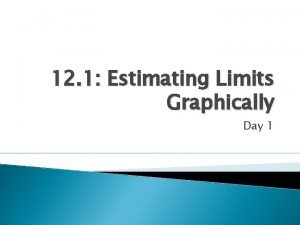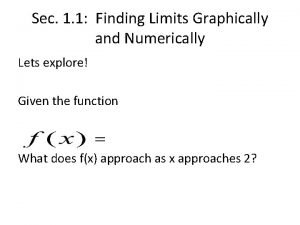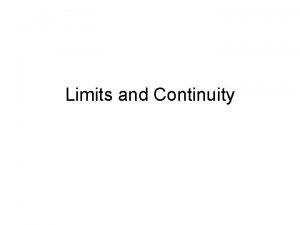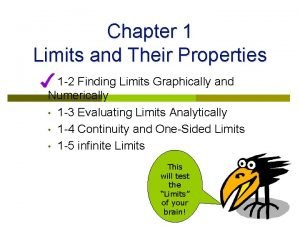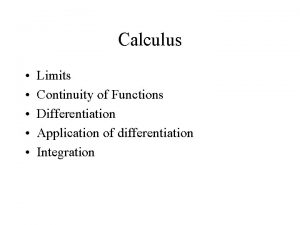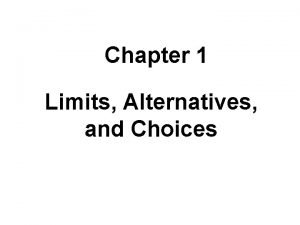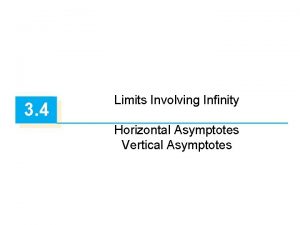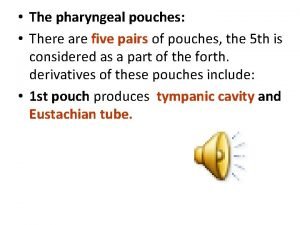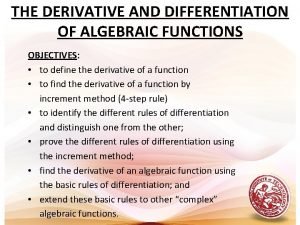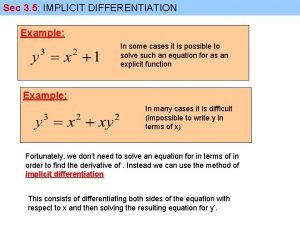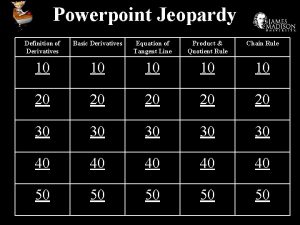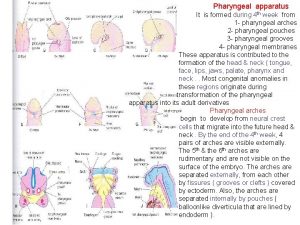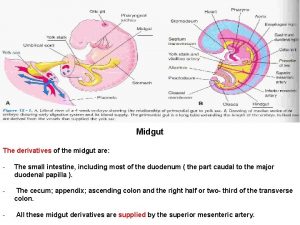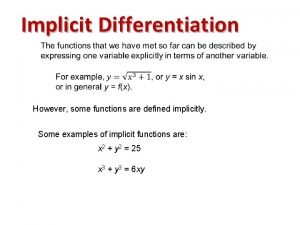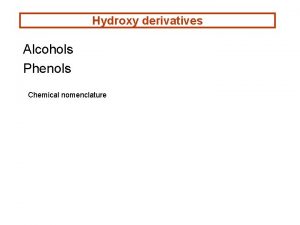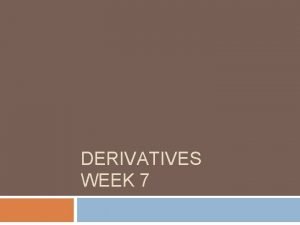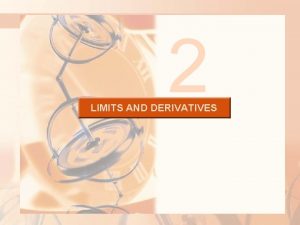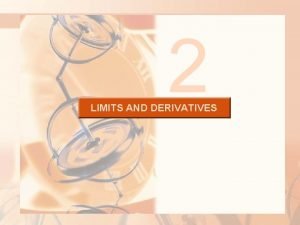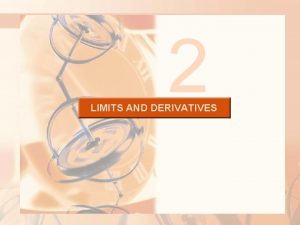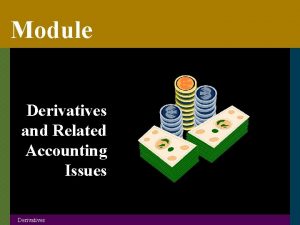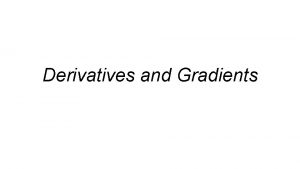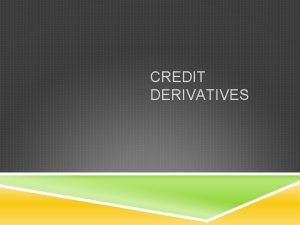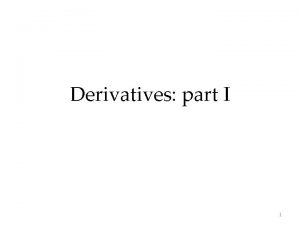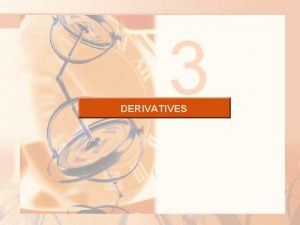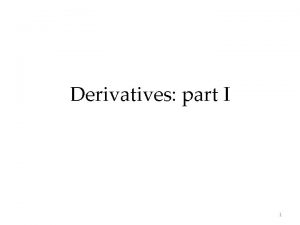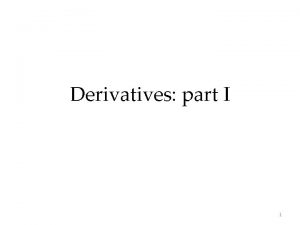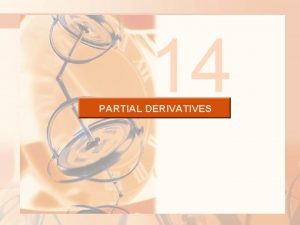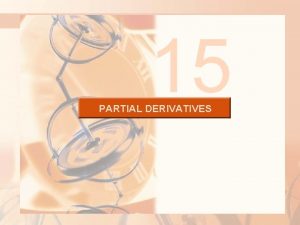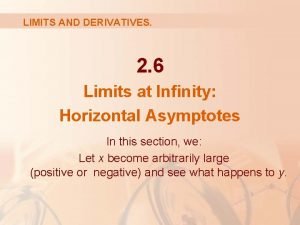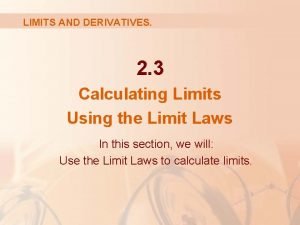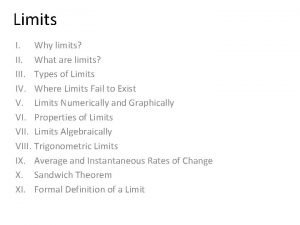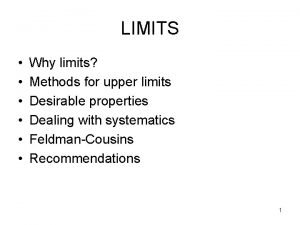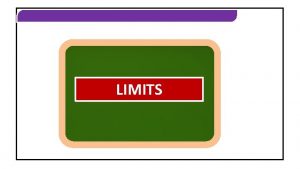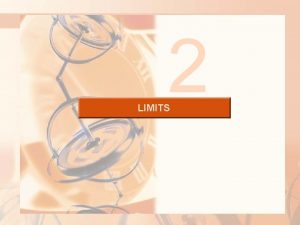2 LIMITS AND DERIVATIVES LIMITS AND DERIVATIVES 2


































































- Slides: 66

2 LIMITS AND DERIVATIVES

LIMITS AND DERIVATIVES 2. 2 The Limit of a Function In this section, we will learn: About limits in general and about numerical and graphical methods for computing them.

THE LIMIT OF A FUNCTION Let’s investigate the behavior of the function f defined by f(x) = x 2 – x + 2 for values of x near 2. § The following table gives values of f(x) for values of x close to 2, but not equal to 2.

THE LIMIT OF A FUNCTION From the table and the graph of f (a parabola) shown in the figure, we see that, when x is close to 2 (on either side of 2), f(x) is close to 4.

THE LIMIT OF A FUNCTION In fact, it appears that we can make the values of f(x) as close as we like to 4 by taking x sufficiently close to 2.

THE LIMIT OF A FUNCTION We express this by saying “the limit of the function f(x) = x 2 – x + 2 as x approaches 2 is equal to 4. ” § The notation for this is:

THE LIMIT OF A FUNCTION Definition 1 In general, we use the following notation. § We write and say “the limit of f(x), as x approaches a, equals L” if we can make the values of f(x) arbitrarily close to L (as close to L as we like) by taking x to be sufficiently close to a (on either side of a) but not equal to a.

THE LIMIT OF A FUNCTION Roughly speaking, this says that the values of f(x) tend to get closer and closer to the number L as x gets closer and closer to the number a (from either side of a) but x a. § A more precise definition will be given in Section 2. 4.

THE LIMIT OF A FUNCTION An alternative notation for is as which is usually read “f(x) approaches L as x approaches a. ”

THE LIMIT OF A FUNCTION Notice the phrase “but x definition of limit. § § § a” in the This means that, in finding the limit of f(x) as x approaches a, we never consider x = a. In fact, f(x) need not even be defined when x = a. The only thing that matters is how f is defined near a.

THE LIMIT OF A FUNCTION The figure shows the graphs of three functions. § Note that, in the third graph, f(a) is not defined and, in the second graph, . § However, in each case, regardless of what happens at a, it is true that.

THE LIMIT OF A FUNCTION Guess the value of Example 1 . § Notice that the function f(x) = (x – 1)/(x 2 – 1) is not defined when x = 1. § However, that doesn’t matter—because the definition of says that we consider values of x that are close to a but not equal to a.

THE LIMIT OF A FUNCTION The tables give values of f(x) (correct to six decimal places) for values of x that approach 1 (but are not equal to 1). § On the basis of the values, we make the guess that Example 1

THE LIMIT OF A FUNCTION Example 1 is illustrated by the graph of f in the figure.

THE LIMIT OF A FUNCTION Example 1 Now, let’s change f slightly by giving it the value 2 when x = 1 and calling the resulting function g:

THE LIMIT OF A FUNCTION Example 1 This new function g still has the same limit as x approaches 1.

THE LIMIT OF A FUNCTION Estimate the value of Example 2 . § The table lists values of the function for several values of t near 0. § As t approaches 0, the values of the function seem to approach 0. 16666666… § So, we guess that:

THE LIMIT OF A FUNCTION Example 2 What would have happened if we had taken even smaller values of t? § The table shows the results from one calculator. § You can see that something strange seems to be happening. § If you try these calculations on your own calculator, you might get different values but, eventually, you will get the value 0 if you make t sufficiently small.

THE LIMIT OF A FUNCTION Example 2 Does this mean that the answer is really 0 instead of 1/6? § No, the value of the limit is 1/6, as we will show in the next section.

THE LIMIT OF A FUNCTION Example 2 The problem is that the calculator gave false values because is very close to 3 when t is small. § In fact, when t is sufficiently small, a calculator’s value for is 3. 000… to as many digits as the calculator is capable of carrying.

THE LIMIT OF A FUNCTION Example 2 Something very similar happens when we try to graph the function of the example on a graphing calculator or computer.

THE LIMIT OF A FUNCTION Example 2 These figures show quite accurate graphs of f and, when we use the trace mode (if available), we can estimate easily that the limit is about 1/6.

THE LIMIT OF A FUNCTION Example 2 However, if we zoom in too much, then we get inaccurate graphs—again because of problems with subtraction.

THE LIMIT OF A FUNCTION Guess the value of Example 3 . § The function f(x) = (sin x)/x is not defined when x = 0. § Using a calculator (and remembering that, if , sin x means the sine of the angle whose radian measure is x), we construct a table of values correct to eight decimal places.

THE LIMIT OF A FUNCTION Example 3 From the table and the graph, we guess that § This guess is, in fact, correct—as will be proved later, using a geometric argument.

THE LIMIT OF A FUNCTION Investigate Example 4 . § Again, the function of f(x) = sin ( /x) is undefined at 0.

THE LIMIT OF A FUNCTION Example 4 Evaluating the function for some small values of x, we get: Similarly, f(0. 001) = f(0. 0001) = 0.

THE LIMIT OF A FUNCTION Example 4 On the basis of this information, we might be tempted to guess that. § This time, however, our guess is wrong. § Although f(1/n) = sin n = 0 for any integer n, it is also true that f(x) = 1 for infinitely many values of x that approach 0.

THE LIMIT OF A FUNCTION Example 4 The graph of f is given in the figure. § The dashed lines near the y-axis indicate that the values of sin( /x) oscillate between 1 and – 1 infinitely as x approaches 0.

THE LIMIT OF A FUNCTION Example 4 § Since the values of f(x) do not approach a fixed number as approaches 0, does not exist.

THE LIMIT OF A FUNCTION Find Example 5 . As before, we construct a table of values. § From the table, it appears that:

THE LIMIT OF A FUNCTION Example 5 § If, however, we persevere with smaller values of x, this table suggests that:

THE LIMIT OF A FUNCTION Example 5 Later, we will see that: § Then, it follows that the limit is 0. 0001.

THE LIMIT OF A FUNCTION Examples 4 and 5 illustrate some of the pitfalls in guessing the value of a limit. § It is easy to guess the wrong value if we use inappropriate values of x, but it is difficult to know when to stop calculating values. § As the discussion after Example 2 shows, sometimes, calculators and computers give the wrong values. § In the next section, however, we will develop foolproof methods for calculating limits.

THE LIMIT OF A FUNCTION Example 6 The Heaviside function H is defined by: § The function is named after the electrical engineer Oliver Heaviside (1850– 1925). § It can be used to describe an electric current that is switched on at time t = 0.

THE LIMIT OF A FUNCTION Example 6 The graph of the function is shown in the figure. § As t approaches 0 from the left, H(t) approaches 0. § As t approaches 0 from the right, H(t) approaches 1. § There is no single number that H(t) approaches as t approaches 0. § So, does not exist.

ONE-SIDED LIMITS We noticed in Example 6 that H(t) approaches 0 as t approaches 0 from the left and H(t) approaches 1 as t approaches 0 from the right. § We indicate this situation symbolically by writing and. § The symbol ‘ ’ indicates that we consider only values of t that are less than 0. § Similarly, ‘ ’ indicates that we consider only values of t that are greater than 0.

ONE-SIDED LIMITS Definition 2 We write and say the left-hand limit of f(x) as x approaches a—or the limit of f(x) as x approaches a from the left—is equal to L if we can make the values of f(x) arbitrarily close to L by taking x to be sufficiently close to a and x less than a.

ONE-SIDED LIMITS Notice that Definition 2 differs from Definition 1 only in that we require x to be less than a. § Similarly, if we require that x be greater than a, we get ‘the right-hand limit of f(x) as x approaches a is equal to L’ and we write. § Thus, the symbol ‘ ’ means that we consider only.

ONE-SIDED LIMITS The definitions are illustrated in the figures.

ONE-SIDED LIMITS By comparing Definition 1 with the definition of one-sided limits, we see that the following is true:

ONE-SIDED LIMITS Example 7 The graph of a function g is displayed. Use it to state the values (if they exist) of:

ONE-SIDED LIMITS Example 7 From the graph, we see that the values of g(x) approach 3 as x approaches 2 from the left, but they approach 1 as x approaches 2 from the right. Therefore, and.

ONE-SIDED LIMITS Example 7 As the left and right limits are different, we conclude that does not exist.

ONE-SIDED LIMITS Example 7 The graph also shows that and.

ONE-SIDED LIMITS For same. Example 7 , the left and right limits are the § So, we have. § Despite this, notice that .

INFINITE LIMITS Find Example 8 if it exists. § As x becomes close to 0, x 2 also becomes close to 0, and 1/x 2 becomes very large.

INFINITE LIMITS Example 8 § In fact, it appears from the graph of the function f(x) = 1/x 2 that the values of f(x) can be made arbitrarily large by taking x close enough to 0. § Thus, the values of f(x) do not approach a number. § So, does not exist.

INFINITE LIMITS Example 8 To indicate the kind of behavior exhibited in the example, we use the following notation: This does not mean that we are regarding ∞ as a number. § Nor does it mean that the limit exists. § It simply expresses the particular way in which the limit does not exist. § 1/x 2 can be made as large as we like by taking x close enough to 0.

INFINITE LIMITS Example 8 In general, we write symbolically to indicate that the values of f(x) become larger and larger—or ‘increase without bound’—as x becomes closer and closer to a.

INFINITE LIMITS Definition 4 Let f be a function defined on both sides of a, except possibly at a itself. Then, means that the values of f(x) can be made arbitrarily large—as large as we please—by taking x sufficiently close to a, but not equal to a.

INFINITE LIMITS Another notation for is: § Again, the symbol is not a number. § However, the expression is often read as ‘the limit of f(x), as x approaches a, is infinity; ’ or ‘f(x) becomes infinite as x approaches a; ’ or ‘f(x) increases without bound as x approaches a. ’

INFINITE LIMITS This definition is illustrated graphically.

INFINITE LIMITS A similar type of limit—for functions that become large negative as x gets close to a—is illustrated.

INFINITE LIMITS Definition 5 Let f be defined on both sides of a, except possibly at a itself. Then, means that the values of f(x) can be made arbitrarily large negative by taking x sufficiently close to a, but not equal to a.

INFINITE LIMITS The symbol can be read as ‘the limit of f(x), as x approaches a, is negative infinity’ or ‘f(x) decreases without bound as x approaches a. ’ § As an example, we have:

INFINITE LIMITS Similar definitions can be given for the one-sided limits: § Remember, ‘ ’ means that we consider only values of x that are less than a. § Similarly, ‘ ’ means that we consider only .

INFINITE LIMITS Those four cases are illustrated here.

INFINITE LIMITS Definition 6 The line x = a is called a vertical asymptote of the curve y = f(x) if at least one of the following statements is true. § For instance, the y-axis is a vertical asymptote of the curve y = 1/x 2 because.

INFINITE LIMITS In the figures, the line x = a is a vertical asymptote in each of the four cases shown. § In general, knowledge of vertical asymptotes is very useful in sketching graphs.

INFINITE LIMITS Find Example 9 and . § If x is close to 3 but larger than 3, then the denominator x – 3 is a small positive number and 2 x is close to 6. § So, the quotient 2 x/(x – 3) is a large positive number. § Thus, intuitively, we see that.

INFINITE LIMITS Example 9 § Similarly, if x is close to 3 but smaller than 3, then x - 3 is a small negative number but 2 x is still a positive number (close to 6). § So, 2 x/(x - 3) is a numerically large negative number. § Thus, we see that.

INFINITE LIMITS Example 9 The graph of the curve y = 2 x/(x - 3) is given in the figure. § The line x – 3 is a vertical asymptote.

INFINITE LIMITS Example 10 Find the vertical asymptotes of f(x) = tan x. § As , there are potential vertical asymptotes where cos x = 0. § In fact, since as and as , whereas sin x is positive when x is near /2, we have: and § This shows that the line x = /2 is a vertical asymptote.

INFINITE LIMITS Example 10 Similar reasoning shows that the lines x = (2 n + 1) /2, where n is an integer, are all vertical asymptotes of f(x) = tan x. § The graph confirms this.

INFINITE LIMITS Example 10 Another example of a function whose graph has a vertical asymptote is the natural logarithmic function of y = ln x. § From the figure, we see that § So, the line x = 0 (the y-axis) is a vertical asymptote. § The same is true for y = loga x, provided a > 1. .
 Derivatives class 11 pdf
Derivatives class 11 pdf Limits and derivatives
Limits and derivatives Limits and derivatives
Limits and derivatives Limits involving infinity asymptotes
Limits involving infinity asymptotes Real limits vs. apparent limits
Real limits vs. apparent limits Product and quotient rules and higher order derivatives
Product and quotient rules and higher order derivatives Sabyonne
Sabyonne Pharyngeal arches diagram
Pharyngeal arches diagram Hedging with forwards
Hedging with forwards Exponential rules
Exponential rules Derivatives of inverse functions and logarithms
Derivatives of inverse functions and logarithms Log and exponential derivatives
Log and exponential derivatives Carboxylic acid derivatives reactions
Carboxylic acid derivatives reactions Forwards vs futures vs options vs swaps
Forwards vs futures vs options vs swaps Carboxylic acid to an ester
Carboxylic acid to an ester Carboxylic acids and their derivatives
Carboxylic acids and their derivatives Hydrolysis of acyl chloride
Hydrolysis of acyl chloride Derivatives of mother sauces
Derivatives of mother sauces Financial engineering derivatives and risk management
Financial engineering derivatives and risk management Derivatives and the shape of a graph
Derivatives and the shape of a graph Options, futures, and other derivatives
Options, futures, and other derivatives Reactions of benzene and its derivatives
Reactions of benzene and its derivatives Wringing method culinary
Wringing method culinary مشتق مثلثاتی
مشتق مثلثاتی Financial engineering derivatives and risk management
Financial engineering derivatives and risk management Financial engineering derivatives and risk management
Financial engineering derivatives and risk management Limit and continuity solved problems
Limit and continuity solved problems Limits fits and tolerances lecture notes
Limits fits and tolerances lecture notes Radiation dose limits for workers and public pdf
Radiation dose limits for workers and public pdf Limits
Limits 8f7 tolerance
8f7 tolerance Chapter 1 limits and their properties
Chapter 1 limits and their properties Limits and their properties
Limits and their properties Fundamental deviation
Fundamental deviation Thomas calculus limits and continuity
Thomas calculus limits and continuity Index of consistency
Index of consistency Mathgotserved
Mathgotserved Finding limits graphically
Finding limits graphically Find limit
Find limit Limits at infinity horizontal asymptotes
Limits at infinity horizontal asymptotes 12-1 practice estimating limits graphically
12-1 practice estimating limits graphically Limits and continuity
Limits and continuity Finding limits graphically
Finding limits graphically Limits and continuity
Limits and continuity Analyzing limits graphically
Analyzing limits graphically Chapter 1 limits and their properties
Chapter 1 limits and their properties Trig limits
Trig limits Application of limits and continuity
Application of limits and continuity Society's economizing problem involves
Society's economizing problem involves Vertical solution
Vertical solution Fifth pharyngeal pouch
Fifth pharyngeal pouch Algebraic differentiation
Algebraic differentiation Differentiate trigonometric functions
Differentiate trigonometric functions Find y
Find y Stomodeum
Stomodeum Least reactive carboxylic acid derivatives
Least reactive carboxylic acid derivatives Derivatives of paraxial mesoderm
Derivatives of paraxial mesoderm Foregut, midgut hindgut derivatives
Foregut, midgut hindgut derivatives Implicit derivative
Implicit derivative Urushiol is a hydroxy derivative of phenol.
Urushiol is a hydroxy derivative of phenol. Germ layers of embryo
Germ layers of embryo Higher order derivatives notation
Higher order derivatives notation Prenotochordal cells
Prenotochordal cells Development of superior vena cava
Development of superior vena cava Veins
Veins Spoticash scam
Spoticash scam Stoxx blue chip
Stoxx blue chip
